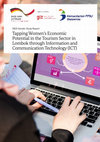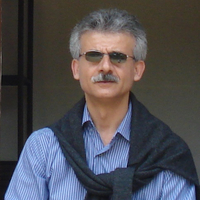Papers by Sarah Schneider
Th ere are thr ee fem ale GM s wit hin the San tika Gro up. If thi s hot el wo uld hav e ano the ... more Th ere are thr ee fem ale GM s wit hin the San tika Gro up. If thi s hot el wo uld hav e ano the r floo r, I wo uld ma ke a lad y's floo r. So, all fem ale gue sts wo uld hav e fem ale inte rio r des ign ed roo ms , cle ane d by fem ale sta ff. We are thi nki ng on how to ma xim ize it. We can pro vid e PO LTE KPA R stu den ts wit h e-c om me rce tra inin g, abo ut dat a ana lysi s, pri cin g stra teg y for roo ms , and yie ldin g.
The interviews build the core foundation of my MA thesis on Fostering Women's Economic Participat... more The interviews build the core foundation of my MA thesis on Fostering Women's Economic Participation in Tourism through the Use of Information and Communication Technology: A Case Study of Lombok, Indonesia.

GIZ, 2019
This gender study report is based on the key outcomes of interviews conducted with representative... more This gender study report is based on the key outcomes of interviews conducted with representatives from local governments and ministries, the private and public sector, donors, NGOs, Islamic boarding schools, and civil society. The interviews were conducted between March and June 2018 in Lombok and Jakarta. The gender study aims was to identify how the use of information and communication technology (ICT) can serve as a powerful catalyst to foster women’s economic participation in the tourism sector in Lombok.
The tourism industry offers many opportunities to women, as they can be engaged as craftswomen, in tourism promotion, working as guides, as front liners, and as creators of travel packages. However, these women often work in informal employment. Recognising gender issues within the tourism industry is essential to ensure sustainable economic development.
One way to empower women’s economic participation is through ICT trainings that would benefit and enhance their digital entrepreneurship and innovation. The importance of using ICT was confirmed during interviews with the Ministry of Tourism (MoT) and their “Digital Tourism” priority program, and the programme of the Ministry for Cooperatives and Small and Medium Enterprises (MoCS) to provide digital literacy trainings for (female) entrepreneurs to engage in and create online marketing platforms to sell their local products.
The advancement of tourism development and gender equal paid jobs can break the poverty cycle through formal and informal employment. Women can gain more benefits through necessary training in entrepreneurship in tourism. ICT benefits gender equality as it decreases the gender digital divide, and advances women’s economic empowerment. To improve digital marketing skills for women, the report provides the potential follow up activities to be integrated into the bilateral Innovation and Investment for Inclusive Sustainable Economic Development (ISED) project that is implemented in Indonesia by GIZ together with its local partners and the Indonesian National Development Planning Agency (BAPPENAS) as the executing agency. The results of the interviews are aligned with the following Sustainable Development Goals: SDG 4 quality education, SDG 8 decent work and economic growth, SDG 10 reduced inequalities, and SDG 12 responsible consumptions, in particular 12.B develop and implement tools to monitor sustainable development impacts for sustainable tourism that creates jobs and promotes local culture and products. In addition, the gender study reveals the potential ISED contribution to two additional SDGs, namely SDG 5 (gender equality) and SDG 9 (industry, innovation and infrastructure). Their fulfilment and connection with the ISED results matrix outputs are presented in the report. Lessons learned are taken from previous projects implemented by GIZ, such as SED-TVET (Sustainable Economic Development through Technical and Vocational Education and Training) with SMK1 Girls Innovation Camp, and SREGIP (Sustainable Regional Economic Growth and Investment Programme) with online marketing for tourism SMEs. The gender study report concludes with a brief feasibility analysis of potential collaborators, activities and target groups and links these to ISED’s solutionoriented outputs and indicators.

Summary of the B.A. thesis of Sarah Schneider, submitted to the Department of Southeast Asian Stu... more Summary of the B.A. thesis of Sarah Schneider, submitted to the Department of Southeast Asian Studies, Johann Wolfgang Goethe-University Frankfurt am Main in May 2015 / Ringkasan skripsi B.A. oleh Sarah Sarah Schneider, Jurusan Kajian Asia Tenggara, Johann Wolfgang Goethe-University Frankfurt, Mei 2015
Summary (English):
The object of my thesis is ‘Budaya Panji’ - ‘Panji-culture’ in the context of intangible cultural heritage of Indonesia. This thesis aims to investigate the potential of this indigenous culture by outlining its competence and to question whether it fulfills the criteria for being inscribed on the UNESCO Representative List of the Intangible Cultural Heritage of Humanity. The research method I used to collect my information is primarily based on academic literature and accessed through the OPAC system of the university library in Frankfurt. In addition, I made use of sources such as academic papers, popular literature, local newspapers, and internet websites.
This thesis has three major purposes: (1) to outline the potential of this indigenous culture by providing a historical background of the Panji stories, their representations in literature, fine arts, performing arts in Indonesia, as well as in Mainland Southeast Asia.; furthermore to outline the symbolic meaning of the Panji stories which comprise simplicity, harmony and fertility; (2) discussing the implementation of the Panji-culture nowadays which is reflected in the media, in art activities, and in scholarly activities; (3) to demonstrate that it is worth being nominated on the Representative List and to outline the conditions of inscribing Panji-culture on the Representative List. In conclusion, the thesis aims to prove that Panji-culture is high in potentiality and is regarded as an intangible cultural heritage of Indonesia regardless of the inscription on the Representative List. However, before Panji-culture can fully be inscribed, it must be included in the Intangible Cultural Heritage National Inventory of Indonesia first, which is carried out by the Ministry of Culture and Tourism in collaboration with the UNESCO Office, in Jakarta. This thesis hopes to raise awareness of Panji-culture, and thus make a contribution to the academic discourse and diversity of Indonesia’s culture. In particular it intends to enhance the safeguarding of the intangible cultural heritage of Indonesia.
Introduction
Indonesia is an archipelago located in Southeast Asia and is, through its broad variety of ethnic groups, rich in tangible as well as intangible cultural forms. This thesis is dealing with the intangible cultural heritage of Indonesia. The United Nations Educational, Scientific and Cultural Organization referred to as UNESCO, was founded in 1945 in order to establish networks among the different nations in the world. By promoting education, protecting freedom of expression, pursuing scientific cooperation and building intercultural understanding, UNESCO strives to enable solidarity among the nations. In order to protect heritage and support cultural diversity, UNESCO created the idea of World Heritage to help preserve endangered heritages. Germany has currently 40 cultural properties inscribed on the World Heritage List. The most recent nomination is the Hamburg Speicherstadt, nominated in 2015. This nomination has a huge impact on Hamburg and Germany, as it can be seen in various media articles (Frankfurter Allgemeine Zeitung). The most famous cultural properties in Indonesia, which have been inscribed on the World Heritage List by UNESCO, are the Buddhist Temple Compound Borobudur (8th century) and the Hindu Temple Compound of Prambanan (9th century) which are both located in Central Java. These historic places are examples of tangible/material heritage and represent outstanding universal values, which are considered worthy of preservation for the future. UNESCO is also concerned with the preservation of cultural expressions, such as maintaining social customs, oral traditions, music, rituals, festivals, arts and crafts skills. These expressions are called intangible cultural heritage. Well-known intangible cultural forms of Indonesia are wayang puppet theatre, kris, batik and the angklung musical instruments. In this work I investigate the case of Panji-culture which represents a cultural identity of East Java that needs to be preserved as a cultural heritage (Nurcahyo 2009:30). It is based on the unique Panji stories which became popular during the Majapahit kingdom in East Java in the late fourteenth and early fifteenth centuries (Vickers 2013).
The Panji stories were first orally transmitted as myths and legends, then written down on palm leaves. Throughout the years, Panji stories have been visually presented and depicted through fine arts, such as in temple reliefs and sculptures, as well as through performing arts, such as various wayang and topeng performances. As the Panji stories spread in Mainland Southeast Asia, there evolved different versions of the stories which contributed to the diversity and potential of the Panji-culture today. Thailand, Myanmar, Cambodia and Laos have their own interpretation of the stories. The submission of the Panji stories as documentary heritage to the UNESCO Memory of the World programme by the National Library of Indonesia in 2014 is still in process.
In chapter I, a brief introduction to the figure Panji will be given. The first part of chapter II defines the terms ‘heritage’ and ‘cultural heritage’. Subsequently, the distinction between ‘tangible’ and ‘intangible’ heritage will be explained. The Convention for the Safeguarding of the Intangible Cultural Heritage will be introduced with its major articles which are relevant for further discussion of this thesis. The second part of chapter II deals with heritage of Indonesia. The third part outlines the criteria for an intangible cultural heritage to be inscribed. Chapter III gives a description of the historical background of the Panji stories. Chapter IV includes background information, contents and characteristics, the representations in literary forms, fine arts, performing arts, and the Balinese and Thai versions of the Panji stories. Chapter V deals with the symbolic meaning of the Panji stories and comprises the sections simplicity, harmony and fertility. Chapter VI introduces the term ‘Budaya Panji’ — ‘Panji-culture’ which comprises the implementation of the Panji-culture nowadays: the ways of its academical representation, the relevant art activities and the ways of its manifestation through press and social media, such as Facebook. Panji-culture has drawn huge attention throughout the last years, with an immense increase in seminars and festivals throughout Indonesia and Southeast Asia, in 2014. The penultimate chapter discusses the conditions of inscribing Panji-culture on the Representative List with its potential and perspectives. By examining the Panji-culture, the final chapter rounds up the findings and concludes that Panji-culture is worth being nominated on the Representative List. Panji-culture represents a cultural pillar not only for Indonesia but for other Southeast Asian countries, as well.











Uploads
Papers by Sarah Schneider
The tourism industry offers many opportunities to women, as they can be engaged as craftswomen, in tourism promotion, working as guides, as front liners, and as creators of travel packages. However, these women often work in informal employment. Recognising gender issues within the tourism industry is essential to ensure sustainable economic development.
One way to empower women’s economic participation is through ICT trainings that would benefit and enhance their digital entrepreneurship and innovation. The importance of using ICT was confirmed during interviews with the Ministry of Tourism (MoT) and their “Digital Tourism” priority program, and the programme of the Ministry for Cooperatives and Small and Medium Enterprises (MoCS) to provide digital literacy trainings for (female) entrepreneurs to engage in and create online marketing platforms to sell their local products.
The advancement of tourism development and gender equal paid jobs can break the poverty cycle through formal and informal employment. Women can gain more benefits through necessary training in entrepreneurship in tourism. ICT benefits gender equality as it decreases the gender digital divide, and advances women’s economic empowerment. To improve digital marketing skills for women, the report provides the potential follow up activities to be integrated into the bilateral Innovation and Investment for Inclusive Sustainable Economic Development (ISED) project that is implemented in Indonesia by GIZ together with its local partners and the Indonesian National Development Planning Agency (BAPPENAS) as the executing agency. The results of the interviews are aligned with the following Sustainable Development Goals: SDG 4 quality education, SDG 8 decent work and economic growth, SDG 10 reduced inequalities, and SDG 12 responsible consumptions, in particular 12.B develop and implement tools to monitor sustainable development impacts for sustainable tourism that creates jobs and promotes local culture and products. In addition, the gender study reveals the potential ISED contribution to two additional SDGs, namely SDG 5 (gender equality) and SDG 9 (industry, innovation and infrastructure). Their fulfilment and connection with the ISED results matrix outputs are presented in the report. Lessons learned are taken from previous projects implemented by GIZ, such as SED-TVET (Sustainable Economic Development through Technical and Vocational Education and Training) with SMK1 Girls Innovation Camp, and SREGIP (Sustainable Regional Economic Growth and Investment Programme) with online marketing for tourism SMEs. The gender study report concludes with a brief feasibility analysis of potential collaborators, activities and target groups and links these to ISED’s solutionoriented outputs and indicators.
Summary (English):
The object of my thesis is ‘Budaya Panji’ - ‘Panji-culture’ in the context of intangible cultural heritage of Indonesia. This thesis aims to investigate the potential of this indigenous culture by outlining its competence and to question whether it fulfills the criteria for being inscribed on the UNESCO Representative List of the Intangible Cultural Heritage of Humanity. The research method I used to collect my information is primarily based on academic literature and accessed through the OPAC system of the university library in Frankfurt. In addition, I made use of sources such as academic papers, popular literature, local newspapers, and internet websites.
This thesis has three major purposes: (1) to outline the potential of this indigenous culture by providing a historical background of the Panji stories, their representations in literature, fine arts, performing arts in Indonesia, as well as in Mainland Southeast Asia.; furthermore to outline the symbolic meaning of the Panji stories which comprise simplicity, harmony and fertility; (2) discussing the implementation of the Panji-culture nowadays which is reflected in the media, in art activities, and in scholarly activities; (3) to demonstrate that it is worth being nominated on the Representative List and to outline the conditions of inscribing Panji-culture on the Representative List. In conclusion, the thesis aims to prove that Panji-culture is high in potentiality and is regarded as an intangible cultural heritage of Indonesia regardless of the inscription on the Representative List. However, before Panji-culture can fully be inscribed, it must be included in the Intangible Cultural Heritage National Inventory of Indonesia first, which is carried out by the Ministry of Culture and Tourism in collaboration with the UNESCO Office, in Jakarta. This thesis hopes to raise awareness of Panji-culture, and thus make a contribution to the academic discourse and diversity of Indonesia’s culture. In particular it intends to enhance the safeguarding of the intangible cultural heritage of Indonesia.
Introduction
Indonesia is an archipelago located in Southeast Asia and is, through its broad variety of ethnic groups, rich in tangible as well as intangible cultural forms. This thesis is dealing with the intangible cultural heritage of Indonesia. The United Nations Educational, Scientific and Cultural Organization referred to as UNESCO, was founded in 1945 in order to establish networks among the different nations in the world. By promoting education, protecting freedom of expression, pursuing scientific cooperation and building intercultural understanding, UNESCO strives to enable solidarity among the nations. In order to protect heritage and support cultural diversity, UNESCO created the idea of World Heritage to help preserve endangered heritages. Germany has currently 40 cultural properties inscribed on the World Heritage List. The most recent nomination is the Hamburg Speicherstadt, nominated in 2015. This nomination has a huge impact on Hamburg and Germany, as it can be seen in various media articles (Frankfurter Allgemeine Zeitung). The most famous cultural properties in Indonesia, which have been inscribed on the World Heritage List by UNESCO, are the Buddhist Temple Compound Borobudur (8th century) and the Hindu Temple Compound of Prambanan (9th century) which are both located in Central Java. These historic places are examples of tangible/material heritage and represent outstanding universal values, which are considered worthy of preservation for the future. UNESCO is also concerned with the preservation of cultural expressions, such as maintaining social customs, oral traditions, music, rituals, festivals, arts and crafts skills. These expressions are called intangible cultural heritage. Well-known intangible cultural forms of Indonesia are wayang puppet theatre, kris, batik and the angklung musical instruments. In this work I investigate the case of Panji-culture which represents a cultural identity of East Java that needs to be preserved as a cultural heritage (Nurcahyo 2009:30). It is based on the unique Panji stories which became popular during the Majapahit kingdom in East Java in the late fourteenth and early fifteenth centuries (Vickers 2013).
The Panji stories were first orally transmitted as myths and legends, then written down on palm leaves. Throughout the years, Panji stories have been visually presented and depicted through fine arts, such as in temple reliefs and sculptures, as well as through performing arts, such as various wayang and topeng performances. As the Panji stories spread in Mainland Southeast Asia, there evolved different versions of the stories which contributed to the diversity and potential of the Panji-culture today. Thailand, Myanmar, Cambodia and Laos have their own interpretation of the stories. The submission of the Panji stories as documentary heritage to the UNESCO Memory of the World programme by the National Library of Indonesia in 2014 is still in process.
In chapter I, a brief introduction to the figure Panji will be given. The first part of chapter II defines the terms ‘heritage’ and ‘cultural heritage’. Subsequently, the distinction between ‘tangible’ and ‘intangible’ heritage will be explained. The Convention for the Safeguarding of the Intangible Cultural Heritage will be introduced with its major articles which are relevant for further discussion of this thesis. The second part of chapter II deals with heritage of Indonesia. The third part outlines the criteria for an intangible cultural heritage to be inscribed. Chapter III gives a description of the historical background of the Panji stories. Chapter IV includes background information, contents and characteristics, the representations in literary forms, fine arts, performing arts, and the Balinese and Thai versions of the Panji stories. Chapter V deals with the symbolic meaning of the Panji stories and comprises the sections simplicity, harmony and fertility. Chapter VI introduces the term ‘Budaya Panji’ — ‘Panji-culture’ which comprises the implementation of the Panji-culture nowadays: the ways of its academical representation, the relevant art activities and the ways of its manifestation through press and social media, such as Facebook. Panji-culture has drawn huge attention throughout the last years, with an immense increase in seminars and festivals throughout Indonesia and Southeast Asia, in 2014. The penultimate chapter discusses the conditions of inscribing Panji-culture on the Representative List with its potential and perspectives. By examining the Panji-culture, the final chapter rounds up the findings and concludes that Panji-culture is worth being nominated on the Representative List. Panji-culture represents a cultural pillar not only for Indonesia but for other Southeast Asian countries, as well.
The tourism industry offers many opportunities to women, as they can be engaged as craftswomen, in tourism promotion, working as guides, as front liners, and as creators of travel packages. However, these women often work in informal employment. Recognising gender issues within the tourism industry is essential to ensure sustainable economic development.
One way to empower women’s economic participation is through ICT trainings that would benefit and enhance their digital entrepreneurship and innovation. The importance of using ICT was confirmed during interviews with the Ministry of Tourism (MoT) and their “Digital Tourism” priority program, and the programme of the Ministry for Cooperatives and Small and Medium Enterprises (MoCS) to provide digital literacy trainings for (female) entrepreneurs to engage in and create online marketing platforms to sell their local products.
The advancement of tourism development and gender equal paid jobs can break the poverty cycle through formal and informal employment. Women can gain more benefits through necessary training in entrepreneurship in tourism. ICT benefits gender equality as it decreases the gender digital divide, and advances women’s economic empowerment. To improve digital marketing skills for women, the report provides the potential follow up activities to be integrated into the bilateral Innovation and Investment for Inclusive Sustainable Economic Development (ISED) project that is implemented in Indonesia by GIZ together with its local partners and the Indonesian National Development Planning Agency (BAPPENAS) as the executing agency. The results of the interviews are aligned with the following Sustainable Development Goals: SDG 4 quality education, SDG 8 decent work and economic growth, SDG 10 reduced inequalities, and SDG 12 responsible consumptions, in particular 12.B develop and implement tools to monitor sustainable development impacts for sustainable tourism that creates jobs and promotes local culture and products. In addition, the gender study reveals the potential ISED contribution to two additional SDGs, namely SDG 5 (gender equality) and SDG 9 (industry, innovation and infrastructure). Their fulfilment and connection with the ISED results matrix outputs are presented in the report. Lessons learned are taken from previous projects implemented by GIZ, such as SED-TVET (Sustainable Economic Development through Technical and Vocational Education and Training) with SMK1 Girls Innovation Camp, and SREGIP (Sustainable Regional Economic Growth and Investment Programme) with online marketing for tourism SMEs. The gender study report concludes with a brief feasibility analysis of potential collaborators, activities and target groups and links these to ISED’s solutionoriented outputs and indicators.
Summary (English):
The object of my thesis is ‘Budaya Panji’ - ‘Panji-culture’ in the context of intangible cultural heritage of Indonesia. This thesis aims to investigate the potential of this indigenous culture by outlining its competence and to question whether it fulfills the criteria for being inscribed on the UNESCO Representative List of the Intangible Cultural Heritage of Humanity. The research method I used to collect my information is primarily based on academic literature and accessed through the OPAC system of the university library in Frankfurt. In addition, I made use of sources such as academic papers, popular literature, local newspapers, and internet websites.
This thesis has three major purposes: (1) to outline the potential of this indigenous culture by providing a historical background of the Panji stories, their representations in literature, fine arts, performing arts in Indonesia, as well as in Mainland Southeast Asia.; furthermore to outline the symbolic meaning of the Panji stories which comprise simplicity, harmony and fertility; (2) discussing the implementation of the Panji-culture nowadays which is reflected in the media, in art activities, and in scholarly activities; (3) to demonstrate that it is worth being nominated on the Representative List and to outline the conditions of inscribing Panji-culture on the Representative List. In conclusion, the thesis aims to prove that Panji-culture is high in potentiality and is regarded as an intangible cultural heritage of Indonesia regardless of the inscription on the Representative List. However, before Panji-culture can fully be inscribed, it must be included in the Intangible Cultural Heritage National Inventory of Indonesia first, which is carried out by the Ministry of Culture and Tourism in collaboration with the UNESCO Office, in Jakarta. This thesis hopes to raise awareness of Panji-culture, and thus make a contribution to the academic discourse and diversity of Indonesia’s culture. In particular it intends to enhance the safeguarding of the intangible cultural heritage of Indonesia.
Introduction
Indonesia is an archipelago located in Southeast Asia and is, through its broad variety of ethnic groups, rich in tangible as well as intangible cultural forms. This thesis is dealing with the intangible cultural heritage of Indonesia. The United Nations Educational, Scientific and Cultural Organization referred to as UNESCO, was founded in 1945 in order to establish networks among the different nations in the world. By promoting education, protecting freedom of expression, pursuing scientific cooperation and building intercultural understanding, UNESCO strives to enable solidarity among the nations. In order to protect heritage and support cultural diversity, UNESCO created the idea of World Heritage to help preserve endangered heritages. Germany has currently 40 cultural properties inscribed on the World Heritage List. The most recent nomination is the Hamburg Speicherstadt, nominated in 2015. This nomination has a huge impact on Hamburg and Germany, as it can be seen in various media articles (Frankfurter Allgemeine Zeitung). The most famous cultural properties in Indonesia, which have been inscribed on the World Heritage List by UNESCO, are the Buddhist Temple Compound Borobudur (8th century) and the Hindu Temple Compound of Prambanan (9th century) which are both located in Central Java. These historic places are examples of tangible/material heritage and represent outstanding universal values, which are considered worthy of preservation for the future. UNESCO is also concerned with the preservation of cultural expressions, such as maintaining social customs, oral traditions, music, rituals, festivals, arts and crafts skills. These expressions are called intangible cultural heritage. Well-known intangible cultural forms of Indonesia are wayang puppet theatre, kris, batik and the angklung musical instruments. In this work I investigate the case of Panji-culture which represents a cultural identity of East Java that needs to be preserved as a cultural heritage (Nurcahyo 2009:30). It is based on the unique Panji stories which became popular during the Majapahit kingdom in East Java in the late fourteenth and early fifteenth centuries (Vickers 2013).
The Panji stories were first orally transmitted as myths and legends, then written down on palm leaves. Throughout the years, Panji stories have been visually presented and depicted through fine arts, such as in temple reliefs and sculptures, as well as through performing arts, such as various wayang and topeng performances. As the Panji stories spread in Mainland Southeast Asia, there evolved different versions of the stories which contributed to the diversity and potential of the Panji-culture today. Thailand, Myanmar, Cambodia and Laos have their own interpretation of the stories. The submission of the Panji stories as documentary heritage to the UNESCO Memory of the World programme by the National Library of Indonesia in 2014 is still in process.
In chapter I, a brief introduction to the figure Panji will be given. The first part of chapter II defines the terms ‘heritage’ and ‘cultural heritage’. Subsequently, the distinction between ‘tangible’ and ‘intangible’ heritage will be explained. The Convention for the Safeguarding of the Intangible Cultural Heritage will be introduced with its major articles which are relevant for further discussion of this thesis. The second part of chapter II deals with heritage of Indonesia. The third part outlines the criteria for an intangible cultural heritage to be inscribed. Chapter III gives a description of the historical background of the Panji stories. Chapter IV includes background information, contents and characteristics, the representations in literary forms, fine arts, performing arts, and the Balinese and Thai versions of the Panji stories. Chapter V deals with the symbolic meaning of the Panji stories and comprises the sections simplicity, harmony and fertility. Chapter VI introduces the term ‘Budaya Panji’ — ‘Panji-culture’ which comprises the implementation of the Panji-culture nowadays: the ways of its academical representation, the relevant art activities and the ways of its manifestation through press and social media, such as Facebook. Panji-culture has drawn huge attention throughout the last years, with an immense increase in seminars and festivals throughout Indonesia and Southeast Asia, in 2014. The penultimate chapter discusses the conditions of inscribing Panji-culture on the Representative List with its potential and perspectives. By examining the Panji-culture, the final chapter rounds up the findings and concludes that Panji-culture is worth being nominated on the Representative List. Panji-culture represents a cultural pillar not only for Indonesia but for other Southeast Asian countries, as well.